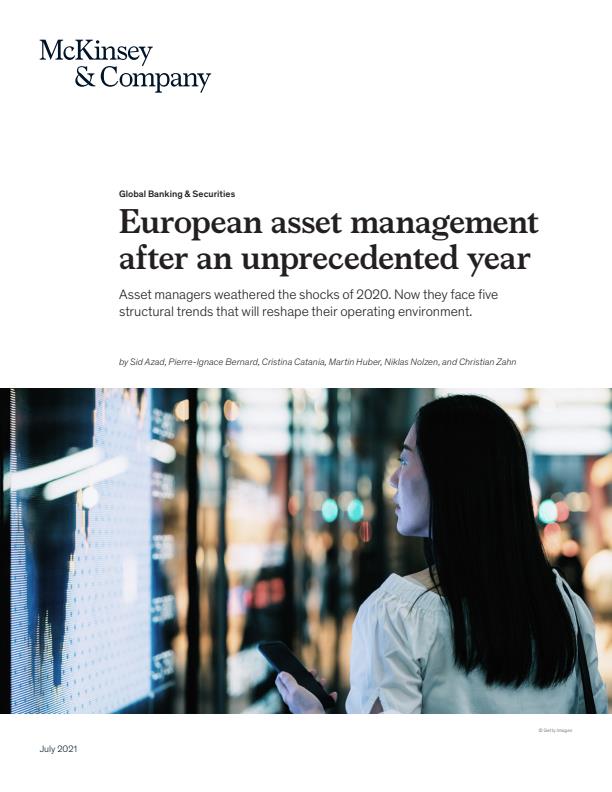The European asset management industry entered 2020 coming off record highs in aggregate revenues and profits. Then COVID-19 emerged early in the year, wreaking havoc on a global scale. While the human suffering and economic impact is ongoing, European asset managers weathered the challenges, ending the year with a record €25.2 trillion in assets under management (AUM), up 5 percent over 2019.
Overall, 2020 proved to be unprecedented for asset managers, as it was for so many business sectors. The year’s extreme conditions emphasize the industry’s shortcomings but also opportunities for further growth and enhancement of its standing with clients and the public at large. In this summary, we set out the most important trends facing asset managers and offer strategic recommendations for moving the industry forward once the COVID-19 crisis is past. In the full report, European asset management after an unprecedented year, we provide more detail and data for the full story.
A year of shocks—and new highs
The markets underwent intense stress toward the end of March 2020, and accordingly, European investors sought safer assets, withdrawing more than €100 billion in the first quarter. Markets quickly recovered, however, and with them net flows into long-term investments. The resulting €750 billion in net flows across all asset classes and segments increased European managers’ AUM by 3.2 percent for all of 2020, the third-highest annual net flow effect over the preceding 13 years.
In total, AUM in Western Europe expanded by €1.2 trillion to €25.2 trillion in 2020, a rate of 5 percent. However, rates of AUM growth slowed quite a bit: growth in institutional assets fell from 12 percent in 2019 to 5 percent, while retail asset growth declined from 15 percent to 6 percent.
The Western European revenue pool grew 7 percent for the year to €55 billion, and the profit pool increased 11 percent, to €22.8 billion. However, Europe’s managers again struggled to exploit the operating leverage once thought to be a fundamental feature of the business. Revenue margins eroded a bit, cost margins dropped by almost 1 percent, and overall profit margins were little changed at 13.6 percent, well below the industry’s 2007 peak (exhibit).

Looking deeper into these numbers, however, the absolute cost pool grew at 4.2 percent for 2020, highlighting how heavily the industry’s profitability relies on rising markets.
If asset managers can indeed focus on capitalizing on their economies of scale through greater control over costs, we estimate a significant potential for incremental profits—on the order of €15 billion. But the core question remains: Given the industry’s challenges in costs and competition, how can asset managers recapture their inherent operating leverage?
Would you like to learn more about our Financial Services Practice?
Structural trends shaping Europe’s asset management landscape
While Europe’s asset managers emerged from 2020 in good financial shape, they still face important challenges from the economic, market, and social environments. In the full paper, we set out five trends and their impacts—some of long standing, others more recently emerged—here are a few of them.
Loose monetary policy
Accommodative central-bank policy has prevailed since the financial crisis and was further eased in first quarter 2020. A prolonged period of easy money policy will likely continue to support equity markets while suppressing the returns to fixed income, with commensurate responses in demand from retail investors.
Government intervention
Public deficits are expected to grow in the European Union to 95 percent of GDP by end of 2021. Ongoing fiscal stimulus to mitigate the economic impact will shape the future business cycle, and asset managers must evaluate the potential consequences when developing portfolio strategies.
A focus on environmental, social, and governance (ESG) performance
Governments and corporates in Europe have increasingly focused on sustainable investments, offering an opening for asset managers to show leadership in guiding Europe to a greener path and improved sustainability.
We also point to the momentum in trends toward digital business and the regionalization of the European economy. While digital channels are not new, COVID-19 has increased consumer and employee comfort with remote tools and working, calling for adjustments in portfolio holdings in favor of the more dynamic companies.
As for regionalization, European asset managers can expect increasing challenges in cross-regional ventures, stemming from country- and region-specific regulation, and greater pressure on managers to offer more localized and focused products.

The future of private banking in Europe: Preparing for accelerated change
Rethinking asset management
Historically, the function of the asset management business was relatively straightforward: to serve as a financial conduit, matching private and institutional sources of capital seeking returns with firms needing capital for investment. Today the industry is more complex, serving a wider range of investor needs and objectives for growth, income, and capital. In our view, Europe’s asset managers must act on three broad imperatives to ensure a sound future.
1. Play a leadership role in shaping a sustainable future
As a group, asset managers have a voice that is heard by corporate boards around the world, and they should establish a leading position. They can do so by supporting the initiatives of governments, nongovernmental organizations, and industry groups and by steering capital flows in the most productive and sustainable directions.
2. Embrace technology disruptions
The shift to remote working in response to COVID-19 is an early indicator of the technological change we expect to occur over the next decade. The road forward for asset managers should include transforming their organizations to become more adaptive and continually learning.
3. Move the boundaries to capture additional profit pools
We see two levers for growth for Europe’s asset managers: capturing economies of scale and pushing the limits of the asset management market to new frontiers. To realize economies of scale, asset managers have to assess their firms’ operating models with an eye toward scalability, adopt cost-saving technologies, and decrease operating-model complexity.
From the perspective of revenue growth, managers need to undertake a dedicated effort to understand unsatisfied and underserved investor needs, so they can articulate a more compelling value proposition. This can take many forms: alpha generation, superior execution, simplified market access, improved risk control, richer diversification, and fulfillment of clients’ ESG goals.
For a deeper dive on the findings, download the full report from which this article is extracted, European asset management after an unprecedented year (PDF–8.0MB).



